© Copyright Atlanta Coin Expositions, 2008-2025. All Rights Reserved.
Several of the links on the pages within this web site go to affiliate vendors.
A vendor affiliation can mean a small monetary compensation to the web site owner at no additional cost to you.
Several of the links on the pages within this web site go to affiliate vendors.
A vendor affiliation can mean a small monetary compensation to the web site owner at no additional cost to you.
Coin Show
Information
Shop
General
Next Monthly Coin Show
Coin Show - Monthly Notes from November 2019
Ancient Coin Constantine I
East German Police Medal
The November 2019 Greater Atlanta Coin Show greeted many visitors to a bourse filled with dealers and their showcases of numismatic and other types of collectibles.
We appreciate the many people who take a few hours on one Sunday each month to visit the coin show to see what new treasures can be found.
We also appreciate those who bring items for appraisal and potential sale to the dealers.
And, those who just want to see what a coin show is and just look at the many historical items on display are always welcome too.
We appreciate the many people who take a few hours on one Sunday each month to visit the coin show to see what new treasures can be found.
We also appreciate those who bring items for appraisal and potential sale to the dealers.
And, those who just want to see what a coin show is and just look at the many historical items on display are always welcome too.
Ancient Coin Gordian III
Ancient Coin Septimius Severus
Bank of Augusta Note
Root Beer Citrine
Of course, the hotel offers space for other venues, and this month we spotted people attending the churches in the hotel.
We also saw a few models that came to the Barbazon event at the hotel.
In other words, the hotel offered an interesting cross section of visitors on a November Sunday.
As usual, we had people attending the show looking for specific coins and bullion while others brought items to sell.
Let's take a virtual tour of just a few of the items seen on the bourse.
We also saw a few models that came to the Barbazon event at the hotel.
In other words, the hotel offered an interesting cross section of visitors on a November Sunday.
As usual, we had people attending the show looking for specific coins and bullion while others brought items to sell.
Let's take a virtual tour of just a few of the items seen on the bourse.
This month, due to a scheduling conflict with the Tennessee State Numismatic Society's coin show, we had a few dealers missing from our bourse. But, this gives us an opportunity to invite visiting dealers in their stead.
Thank you to all of the dealers who bring their items for display and to sell. You and your variety make the coin show an interesting treasure hunt for the visitors.
This month's weather provided a relatively nice day with temperatures in the mid 60s under sunny to partly cloudy skies.
Thank you to all of the dealers who bring their items for display and to sell. You and your variety make the coin show an interesting treasure hunt for the visitors.
This month's weather provided a relatively nice day with temperatures in the mid 60s under sunny to partly cloudy skies.

"Constantine the Great, one of the truly great Roman emperors, rose to power when his father Constantius I Chlorus died in the year 306 while campaigning against Scottish tribes.
"During the next several years he gradually consolidated his grip on power, alternating titles between Augustus and Caesar as his rivals died off or were eliminated in the contest for monarchical rule over the Empire.
"During the next several years he gradually consolidated his grip on power, alternating titles between Augustus and Caesar as his rivals died off or were eliminated in the contest for monarchical rule over the Empire.
The first coin is from Rome during the period of 307-337 AD.
The obverse shows "CONSTNTINVS AVG" with laureate head facing right.
The reverse shows "PROVIDENTIAE AVGG" and a camp gate with two turrets.
The Trier mint produced the coin in bronze.
For historical background of Constantine "The Great," one ancient coin web site provides this description:
The obverse shows "CONSTNTINVS AVG" with laureate head facing right.
The reverse shows "PROVIDENTIAE AVGG" and a camp gate with two turrets.
The Trier mint produced the coin in bronze.
For historical background of Constantine "The Great," one ancient coin web site provides this description:
"He is credited for several great landmarks in history.
"He prolonged the life of the Empire over another thousand years by inaugurating a new capital, Constantinople, which went on to be the principal city of the Eastern Empire, Byzantium.
"He adopted Christianity as the official religion and presided over the Council of Nicea in 325, which formulated the basics of Christian faith.
"He abolished the Praetorian Guard and stabilized the currency by re-introducing the gold standard."
Not quite 2000 years old, this coin shows a ruler who worked toward universal power.
"He prolonged the life of the Empire over another thousand years by inaugurating a new capital, Constantinople, which went on to be the principal city of the Eastern Empire, Byzantium.
"He adopted Christianity as the official religion and presided over the Council of Nicea in 325, which formulated the basics of Christian faith.
"He abolished the Praetorian Guard and stabilized the currency by re-introducing the gold standard."
Not quite 2000 years old, this coin shows a ruler who worked toward universal power.
"The praetorians then turned against the two co-emperors, and murdering them, elevated Gordian III as the sole emperor.
"Until 241, Gordian III was under the tutelage of the Senate, which handled the affairs of the empire."
Then he chose a praetorian prefect to assist his rule.
Within a couple of years, his prefect died and the successor overtook Gordian III's position.
Soon thereafter the soldiers murdered the young ex-ruler in February, 244.
This is just one of so many different Roman coins representing just one of many different Roman rulers.
"Until 241, Gordian III was under the tutelage of the Senate, which handled the affairs of the empire."
Then he chose a praetorian prefect to assist his rule.
Within a couple of years, his prefect died and the successor overtook Gordian III's position.
Soon thereafter the soldiers murdered the young ex-ruler in February, 244.
This is just one of so many different Roman coins representing just one of many different Roman rulers.
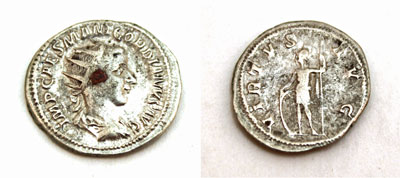
The next coin is another ancient Roman specimen; this time it's Gordian III from 238 to 244 AD.
This coin's obverse includes "IMP CAES M ANT GORDIANVS AVG" with a radiate, draped & cuirassed bust facing right.
On the reverse is "VIRTVS AVG" with Virtus standing in military dress, with head facing left and a hand restingon a shield and holding spear.
This coin's obverse includes "IMP CAES M ANT GORDIANVS AVG" with a radiate, draped & cuirassed bust facing right.
On the reverse is "VIRTVS AVG" with Virtus standing in military dress, with head facing left and a hand restingon a shield and holding spear.
One ancient coins web site describes Gordian III:
"With the emperors dead, the Senate proclaimed two, Balbinus and Pupienus, as joint emperors.
"The two were unpopular in Rome, and shortly thereafter the Senate appointed a third emperor, a teenager grandson of Gordian I, as Gordian III with the rank of Caesar.
"With the emperors dead, the Senate proclaimed two, Balbinus and Pupienus, as joint emperors.
"The two were unpopular in Rome, and shortly thereafter the Senate appointed a third emperor, a teenager grandson of Gordian I, as Gordian III with the rank of Caesar.
Going back in time, the next Roman coin represents Septimius Severus from 193 to 211 AD.
On the obverse, the coin shows "SEVERVS PIVS AVG" with a laureate head facing right.
The coin's reverse includes "P M TR P XVII COS III P P" with Salus seated facing left feeding a snake coiling up from her lap.
On the obverse, the coin shows "SEVERVS PIVS AVG" with a laureate head facing right.
The coin's reverse includes "P M TR P XVII COS III P P" with Salus seated facing left feeding a snake coiling up from her lap.
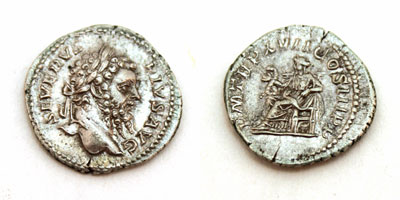
From one of the ancient coins web sites:
"Lucius Septimius Severus was acclaimed as Augustus by his troops after it became known that Didius Julianus had accepted the throne in 193.
"The Praetorians preferred Severus and murdered Julianus.
"Severus was able to enter Rome after a token resistance and his first act was to disband the existing Praetorians and replace them with a force drawn from the Danubian legions who had made him ruler.
"Lucius Septimius Severus was acclaimed as Augustus by his troops after it became known that Didius Julianus had accepted the throne in 193.
"The Praetorians preferred Severus and murdered Julianus.
"Severus was able to enter Rome after a token resistance and his first act was to disband the existing Praetorians and replace them with a force drawn from the Danubian legions who had made him ruler.
"He spent the next four years eliminating his rivals.
"Severus enjoyed time for building, sponsoring cultural life, and strengthening the military arm of the state.
"A military man who wore continuously a military uniform, Severus believed that stability could be achieved by a vast expansion of the military basis of his own power, and this he did.
"He died, in 211, in the middle of a massive expedition aimed at pacifying Northern England and Southern Scotland, after getting fatally ill at York. He was sixty-six."
This coin specimen represents another interesting Roman period.
"Severus enjoyed time for building, sponsoring cultural life, and strengthening the military arm of the state.
"A military man who wore continuously a military uniform, Severus believed that stability could be achieved by a vast expansion of the military basis of his own power, and this he did.
"He died, in 211, in the middle of a massive expedition aimed at pacifying Northern England and Southern Scotland, after getting fatally ill at York. He was sixty-six."
This coin specimen represents another interesting Roman period.
Some of the specimens have clearly cut edges and margins.
Look closely at this one and you'll see irregular edges and margins.
This item gives an insight into the paper money before National Bank Notes.
Look closely at this one and you'll see irregular edges and margins.
This item gives an insight into the paper money before National Bank Notes.
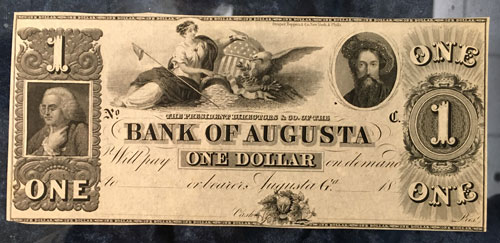
The next item on our tour is numismatic but is not a coin.
This is a One Dollar Note from the Bank of Augusta in the 1800s.
The note printed by Draper, Toppan & Co. of New York and Philadelphia shows "The President, Directors & Co. of the Bank of Augusta will pay One Dollar on demand to _______ or bearer. Augusta Ga. _________ 18 ____."
A space beneath on the left is for the Cashier and on the right for the President to sign.
This is a One Dollar Note from the Bank of Augusta in the 1800s.
The note printed by Draper, Toppan & Co. of New York and Philadelphia shows "The President, Directors & Co. of the Bank of Augusta will pay One Dollar on demand to _______ or bearer. Augusta Ga. _________ 18 ____."
A space beneath on the left is for the Cashier and on the right for the President to sign.
The image at the top shows Liberty with her staff and Phyrgian cap sitting beside a container of coins with a shield under her left arm. An eagle rests with arrows and olive branches in its talons.
On the left, an image of Benjamin Franklin highlights the "1" and "ONE" of the denomination.
This particular note was neither signed nor dated, however there are circulated specimens of this type as early as 1843.
On the left, an image of Benjamin Franklin highlights the "1" and "ONE" of the denomination.
This particular note was neither signed nor dated, however there are circulated specimens of this type as early as 1843.
Side one appears to have a compass and a hammer encircled by a multi-rayed star at the top.
Below is a banner noting the excellent performance of the recipient "für ausgezeichnete Leistungen."
The opposite side shows a larger version of the compass and hammer.
In summary, the medal was awarded for excellent performance of tasks, in particular in the strengthening and consolidation of the GDR.
Below is a banner noting the excellent performance of the recipient "für ausgezeichnete Leistungen."
The opposite side shows a larger version of the compass and hammer.
In summary, the medal was awarded for excellent performance of tasks, in particular in the strengthening and consolidation of the GDR.
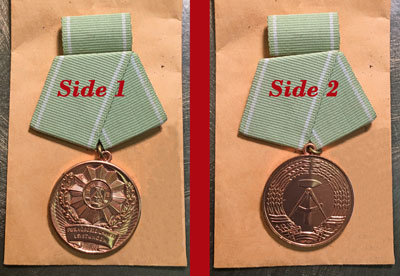
Next on our list is a medal from East Germany.
One source describes the item as the Medal for Excellence in the Armed Organs of the Interior Ministry. In Deutsch: Medaille für ausgezeichnete Leistungen in den bewaffneten Organen des Ministeriums des Innern.
One source describes the item as the Medal for Excellence in the Armed Organs of the Interior Ministry. In Deutsch: Medaille für ausgezeichnete Leistungen in den bewaffneten Organen des Ministeriums des Innern.
In addition to numismatic items, some of our dealers find rocks fascinating.
The next item is called root beer citrine.
Silver Hills Gems describes citrine:
"Color ranges from pale yellow, to medium yellow, to medium-dark orange-yellow, to root beer color.
"Most Citrine on the market is actually a brownish variety of an Amethyst that has been heat treated to produce the bright yellow colors and darker stones with reddish tints. The pale yellow color stones are typically natural untreated stones.
"As the color ranges into medium-dark orange-yellow to Root Beer it is called Madeira Citrine.
The next item is called root beer citrine.
Silver Hills Gems describes citrine:
"Color ranges from pale yellow, to medium yellow, to medium-dark orange-yellow, to root beer color.
"Most Citrine on the market is actually a brownish variety of an Amethyst that has been heat treated to produce the bright yellow colors and darker stones with reddish tints. The pale yellow color stones are typically natural untreated stones.
"As the color ranges into medium-dark orange-yellow to Root Beer it is called Madeira Citrine.
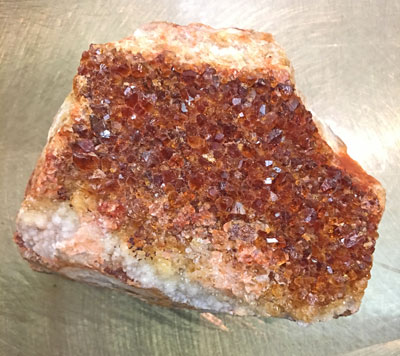
Corvette Emblems
Some of our dealers also enjoy collectible car parts, especially those from the Chevrolet Corvette.
These three emblems each appear to be a nose emblem from the 1977 or 1978 Corvette.
Of course, through the years the Corvette crossed flags emblem has taken several different shapes and illustrations.
These three show a portion of the Chevrolet emblem, the fleur-de-lis with an underscore on the left flag opposite the checkered flag on the right.
The three emblems provide memories of the Corvettes of forty years ago.
These three emblems each appear to be a nose emblem from the 1977 or 1978 Corvette.
Of course, through the years the Corvette crossed flags emblem has taken several different shapes and illustrations.
These three show a portion of the Chevrolet emblem, the fleur-de-lis with an underscore on the left flag opposite the checkered flag on the right.
The three emblems provide memories of the Corvettes of forty years ago.
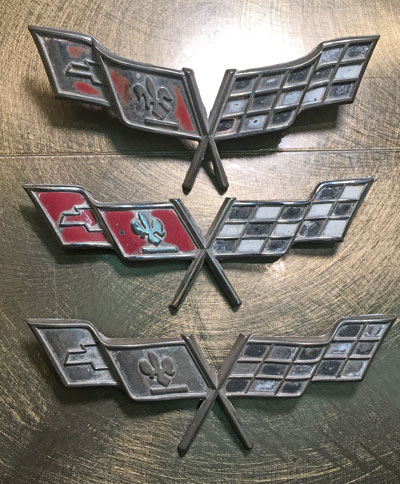
Well, there's just one more show in December for the 2019 Greater Atlanta Coin Shows.
For the last show of the year, the dealers will fill their displays with a wide variety of coins, currency, exonumia and other collectibles.
They will provide many opportunities to find that perfect gift for many on your list for the holiday season. Of course, you can find something for yourself as well.
Mark your calendar and visit the next Greater Atlanta Coin Show on Sunday, December 8, 2019 in the Joe Mack Wilson ballroom to buy, sell, trade or just browse among the many items on display.
For the last show of the year, the dealers will fill their displays with a wide variety of coins, currency, exonumia and other collectibles.
They will provide many opportunities to find that perfect gift for many on your list for the holiday season. Of course, you can find something for yourself as well.
Mark your calendar and visit the next Greater Atlanta Coin Show on Sunday, December 8, 2019 in the Joe Mack Wilson ballroom to buy, sell, trade or just browse among the many items on display.
"Citrine is heat sensitive, excessive heat could turn the stone colorless, an abrupt temperature change may fracture the stone.
"Sources for this gemstone are Brazil, Bolivia, and Madagascar.
"Citrine, a member of the Quartz mineral family, is a Quartz whose color is probably caused by Iron traces.
"Citrine's name is derived from the French Citrine for lemon, it might also come from the Latin ‘citrina’ that means yellow."
This example with its many different hues from light to dark would make an interesting conversation piece.
"Sources for this gemstone are Brazil, Bolivia, and Madagascar.
"Citrine, a member of the Quartz mineral family, is a Quartz whose color is probably caused by Iron traces.
"Citrine's name is derived from the French Citrine for lemon, it might also come from the Latin ‘citrina’ that means yellow."
This example with its many different hues from light to dark would make an interesting conversation piece.
